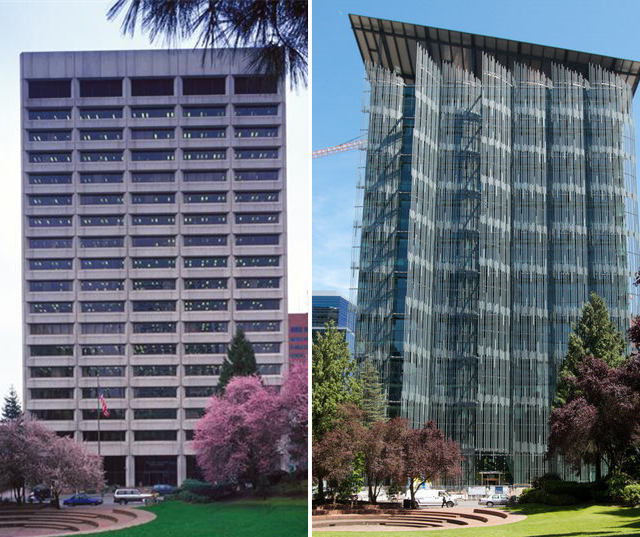
On May 30, Portland, Oregon, celebrated the completion of a $139 million renovation of the 18-story Edith Green-Wendell Wyatt Federal Building (EGWW). First opened in 1975, the boxy, concrete-and-steel high rise, aging home to the IRS, FBI, BLM, and other agencies, was transformed over two years into a towering sustainability showcase.
The metamorphosis was supported by funding from the American Recovery and Reinvestment Act of 2009 (ARRA), as discussed in a previous post. The ARRA enabled the GSA to construct or modernize 270 federal office buildings, laboratories, courthouses, and land ports nationwide. Most of the funds were directed toward converting existing properties into high-performance green buildings, with the complementary goals of energy and cost savings and reduced environmental impacts. GSA Acting Administrator Dan Tangherlini praised the dramatic green improvements of the EGWW, saying, “In many ways, it represents our efforts to best meet the goals of the legislation.”
The site now welcomes tenants and visitors in an open, daylit lobby with a GSA-commissioned photomural depicting the Pacific Northwest forest. Energy-saving renovation highlights include:
- A shading rooftop canopy with 13,000 square feet of photovoltaic panels expected to generate 200,000 kilowatt-hours of electricity annually;
- Solar thermal panels that will provide 30% of the building’s hot water;
- Light reflectors on the south and east facades that enhance daylight penetration in work spaces and minimize summer heat gain;
- Elevators that capture kinetic energy during descent and return it to the building power grid.
Combined, the technologies and design alterations are projected to cut energy consumption compared with the original structure by 55%. The project’s ambitious goal to achieve LEED-Platinum certification would make EGWW only the second GSA property to earn the U.S. Green Building Council’s highest rating.
In addition to energy efficiency, elements expected to score points in the LEED system for existing buildings include LED task lighting and high-efficiency appliances, low-flow toilets, hydronic radiant heating and cooling system, and a rooftop rainwater collection system that recovers stormwater for reuse in toilets, landscape irrigation, and the cooling tower. Water conservation in particular is projected to exceed Oregon code by 55%.
The renovation also offered the opportunity for other essential upgrades. A target of anti-government protests and bomb threats, the EGWW now sports an energy-efficient, blast-resistant curtain wall to protect 1,200 federal workers inside. In replacing the precast-concrete exterior, the makeover moved the building envelope outward and expanded floor space. The space-efficient hydronic HVAC system also recovered 6,000 square feet formerly required for mechanical housing. Such alterations increased the area available for building rentals as well as reducing operation costs and environmental footprint per square foot. Improvements in space utilization are consistent with current efforts to save taxpayer money through downsizing the federal real estate footprint, the topic of a May 22 hearing of the Economic Development, Public Buildings and Emergency Management Subcommittee of the House Transportation and Infrastructure Committee.
With new electrical, mechanical, plumbing, and data systems, the Edith Green-Wendell Wyatt Federal Building has become a centerpiece of GSA’s high-performance building portfolio. One of the country’s most energy efficient buildings, it is projected to meet or exceed Obama Administration directives for agencies to model energy, water, pollution, and waste reduction targets. GSA’s Commissioner of the Public Buildings Service, Dorothy Robyn, expects the cutting-edge structure to serve as a model for future projects. “This suite of mutually beneficial strategies,” says Robyn of EGWW’s many innovations, “can and should be adapted to similar retrofit efforts.”
